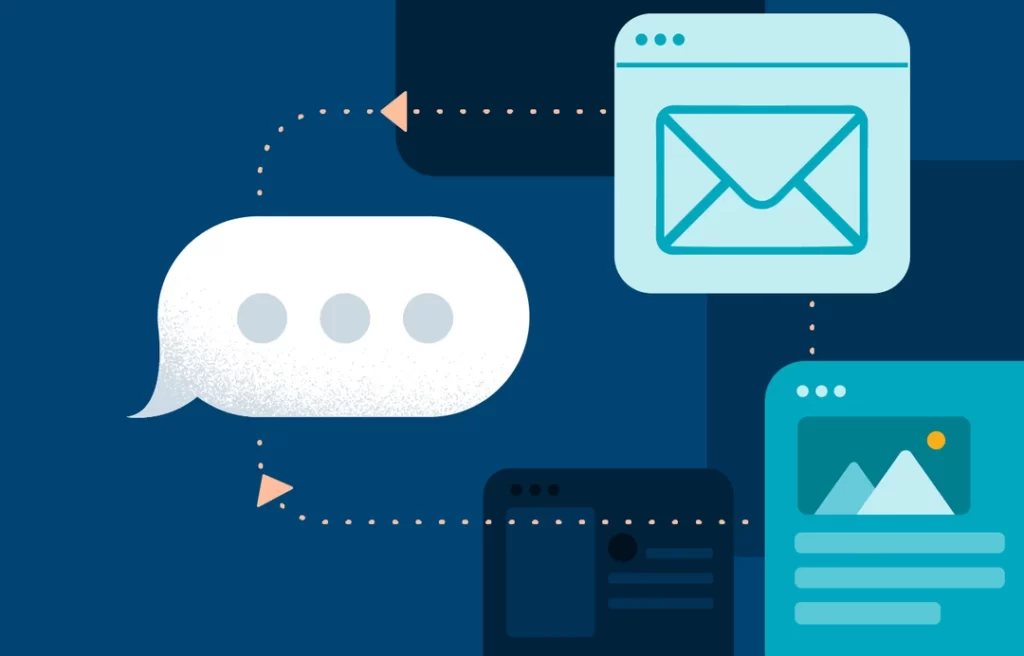The Art and Science of Marketing and Sales
Selling is one of the oldest professions in the world. Since the first exchanges of goods thousands of years ago, salespeople have been finding creative ways to match products and services with customers who want them. But marketing and sales have evolved into a complex dance between technology, psychology, and business strategy in our modern world.
Table of Contents
The Difference Between Marketing and Sales

Many people use “marketing” and “sales” interchangeably, but they refer to distinct processes within a company. Simply put, marketing is everything you do to reach potential customers, while sales are how you convince those customers to purchase.
Marketing refers to strategies for promoting a product, building a brand identity, understanding customer needs, and reaching the right audiences. Sales pick up where marketing leaves off—developing customer relationships, answering their questions, understanding their needs, and closing deals.
Here are a few key differences between the two:
- Marketing is strategic; sales is tactical. Marketing involves high-level decisions about positioning and messaging. Sales focus on conversations with individual customers.
- Marketing attracts customers; sales convinces them to buy. Marketing brings customers to your doorstep, while sales get them to complete a purchase.
- Marketing speaks to the masses; sales speaks to individual leads. Marketing content and campaigns target large audiences. Sales conversations cater to specific potential buyers.
- Marketing identifies needs; sales fills them. Marketers study customer pain points and desires. Sales reps pitch solutions tailored to each lead.
In summary, marketing casts a wide net to catch potential customers while sales reels in each individual. Both are essential to a healthy, growing business. The best companies blend artful marketing with science-based selling techniques.
A Brief History of Modern Marketing
It's hard to imagine a world without Mad Men-style advertising and marketing campaigns. But marketing as we know it today is a relatively recent invention.
In the early 20th century, most products were sold based on word-of-mouth, storefront displays, and direct sales relationships. There were no brands in the modern sense. But between the 1920s and 1950s, several factors came together to give birth to marketing. These included:
- Mass production – With assembly lines and factories, companies could suddenly make more products than they knew how to sell. They needed marketing to increase demand.
- Retail chains – National retailers like Sears, Roebuck & Company created new outlets for branded, mass-produced goods.
- Radio and TV – New broadcast media allowed companies to advertise to a broad audience for the first time.
- Postwar prosperity – After WWII, growing incomes and consumer appetite fueled demand for new products.
Pioneers like Procter & Gamble began sponsoring soap operas on radio and TV. Retailers like Macy's tapped into consumer psychology and developed in-store displays. Designers like Raymond Loewy shaped package designs that created iconic brands. And advertising legends like David Ogilvy perfected copywriting and imagery that tantalised consumers.
The Four P's of Marketing
In 1960, marketing professor E. Jerome McCarthy published a framework called the “marketing mix,” which categorised factors that drive sales into four buckets:
- Product – The features and quality of what you sell
- Price – What you charge for it
- Place – Where and how customers access it
- Promotion – How you communicate its benefits
Now known as the “four P's of marketing,” McCarthy's model still shapes marketing strategy today. It reminds us that psychology, positioning, and persuasion are just as important as the underlying product.
Relationship Marketing and the Modern Buyer's Journey
Old-school marketing techniques are less effective in today's world of extreme consumer choice, attention scarcity, and product parity. Broadcast messages vie for attention against endless digital noise. With online research, buyers are pre-educated before speaking to a sales rep.
Marketers must take cues from the modern buyer's journey to cut through the clutter. Today's customers:
- Do their research – According to Google, 79% of shoppers now conduct online research before making big purchases.
- Seek social proof – 84% of buyers trust online reviews as much as recommendations from people they know.
- Expect personalisation – 74% of consumers get frustrated with generic, untailored marketing.
In response, a new model called relationship marketing has emerged. Relationship marketing focuses on building personal, human connections between brands and consumers. It relies on authentic storytelling, customer communities, influencer partnerships, and excellent customer service.
Relationship marketing is about nurturing consumer affinity over the years and across touchpoints. It's a departure from treating customers as faceless targets—and it often proves more profitable in the long run.
The Modern Marketing Stack
Today's relationship marketing strategies rely on sophisticated tech stacks to automate and optimise the buyer's journey. Here are some of the essential tools:
CRM Software
Customer relationship management tools like Salesforce track every interaction between prospects, leads, and existing customers. CRMs create a single shared database across sales, marketing, and service.
Marketing Automation
Platforms like HubSpot, Marketo, and Pardot streamline personalised email campaigns, lead scoring, and customer nurturing. They help automate multi-channel touchpoints at scale.
Web Analytics
Services like Google Analytics reveal deep insights about on-site engagement, user behaviour, and conversions. Analytics inform marketing optimisation.
Advertising Networks
Platforms like Google Ads, Facebook Ads, and Amazon Ads provide highly targeted PPC and display advertising opportunities.
Email Marketing Software
Tools like MailChimp and Constant Contact design responsive email templates and manage complex subscriber lists and automated email funnels.
Live Chat
Apps like Drift and Intercom enable real-time conversations to capture leads and assist customers on company websites.
Social Media Management
Programs like Hootsuite and Sprout Social simplify cross-platform social promotions, analytics, engagement, and monitoring.
The myriad tools in the marketing stack work together to support a seamless, personalised journey—from first click to loyal customer. Intelligent marketers constantly test and optimise each digital touchpoint.
Inbound Marketing: Creating Value to Earn Attention

Classic “outbound” marketing techniques like TV commercials, print ads, and cold calls take a brute-force approach to getting in front of customers. But today's buyers have finely tuned defence mechanisms against these invasive promotions.
That's why inbound marketing has become popular in recent years. Inbound flips the script on traditional marketing by focusing on attracting customers with relevant, helpful content and experiences.
The inbound methodology follows three phases:
Attract
Use content like blog posts, ebooks, and webinars to attract targeted visitors. Search engine optimisation and sharing on social media can expand reach.
Engage
Convert visitors into leads by encouraging them to exchange emails for gated offers. Begin an automated email campaign to nurture leads.
Delight
Develop relationships over time by providing free tools, resources, and excellent customer service. Turn some leads into happy, loyal brand advocates.
When done well, inbound marketing educates and entertains instead of interrupting. It operates like a tractor beam pulling customers in rather than a bullhorn shouting messages out.
Growth Marketing: Data-driven User Acquisition
Growth marketing refers to digital strategies for rapidly acquiring new users or customers. It combines analytics, programming, psychology, and creativity to build sustainable growth loops.
Popular growth tactics include:
- Viral social campaigns – Create entertaining or informative social content to get shares and engagement.
- Referral programs – Encourage existing customers to refer friends for perks and discounts.
- App store optimisation – Improve keyword rankings, preview media, and reviews to boost downloads.
- Retargeting ads – Remarket to past visitors who didn't convert with display ads on other sites.
- Email funnels – Automated drips that educate, nurture, and convert subscribers over time.
- Partnerships – Strategic brand collaborations that tap into new networks and audiences.
A core goal of growth marketing is systematically improving the user experience to increase engagement, retention, and evangelism. Growth marketers use A/B testing, cohort analysis, funnels, and other data-driven best practices borrowed from SaaS product development.
But unlike spammy, aggressive growth tactics, they always respect the user. Transparency, reciprocity, and compassion are critical tenets of the growth mindset.
The Four S's of Modern Sales Strategy

In past eras, salespeople got by on sheer charisma and powers of persuasion. But in today's buyer-driven marketplace, those natural sales instincts must be supplemented with science and strategy.
Here are four essential pillars of strategic selling in the modern age:
Segmentation
Organise prospects into discrete categories based on attributes like demographics, interests, and buyer stage. Tailor outreach for each segment.
Specialisation
Ensure sales reps are industry and role specialists who understand prospect pain points. Specialisation builds credibility.
Storytelling
Craft compelling narratives that speak to prospects' needs and objections. Stories sell better than stats.
Systemisation
Develop proven sales systems, processes, and training materials that drive repeatable results. Remove variability and guesswork.
Combining artful persuasion with structured systems is the formula for scalable, sustainable sales success.
Blending Digital and Human Touch in Modern Sales
The Internet and CRM tools have automated many sales tasks. But at the end of the day, people still buy from people. That's why many sales organisations take an “omnichannel” approach that combines digital efficiency with human relationship-building.
Here are some ways modern sales teams marry the best of automation and personal selling:
- Lead scoring – CRM algorithms identify qualified prospects for sales follow-up. But reps still craft thoughtful outreach.
- Behavioural emails – Triggered emails send timely, hyper-targeted offers. But reps relationship-build via phone and email.
- Live chat – Real-time chatbots qualify leads. Then, reps take over with personal consulting.
- Sales acceleration software – AI-driven tools recommend content and actions to reps. But reps choose the human touch.
- Virtual selling – Reps use video platforms to mimic real in-person meetings. But relationships still develop.
So, technology handles the routing, recommending, and reporting. But people still provide the listening, advising, and resonating. Blending the two is the winning digital sales model.
The Consultative Sales Approach
In the past, salespeople got away with glossy pitches, sneaky tricks, high pressure, and shallow relationships. But today's buyers see right through old-school tactics. They expect salespeople to act as trusted advisors rather than used car salespeople.
The consultative approach has become the gold standard in modern selling. Consultative selling focuses on understanding a prospect's unique needs and goals and making customised recommendations.
The steps of consultative selling include:
- Asking probing questions to unpack needs
- Listening 80% of the time, talking 20%
- Brainstorming alternative solutions
- Advising on best-fit options
- Explaining implementation and ROI
- Guiding the Buyer Journey
- Being a responsive, patient resource
With this approach, prospects never feel pushed into a deal. Instead, they feel like the salesperson cares about their business first. This establishes immense goodwill and credibility.
Though it takes more time upfront, consultants convert prospects at much higher rates by earning trust. Patience and service pay off.
Harnessing Inbound, Content Marketing, and Thought Leadership

Imagine attending a conference where one vendor dragged you into their exhibit booth to pitch you. Now, imagine how much more interested you'd be in chatting with vendors who took the time to share valuable insights on stage.
The same concept applies online. Pushing salesy messages at prospects feels invasive. But sharing your expertise through thought leadership content pulls them in.
That's why inbound marketing and content creation are effective for starting constructive conversations. Savvy sales teams harness blogs, ebooks, webinars, and videos to:
- Attract Ideal Prospects – Quality content ranks high in search and gets social shares within your target industries and titles. Those who download and attend are pre-qualified.
- Earn credibility – When you teach rather than pitch, prospects see you as a trusted resource rather than a salesperson. You establish authority.
- Shape the conversation – Content allows you to frame the narrative around customer needs you solve. Instead of answering RFPs, you seed prospect priorities.
- Automate and scale – Well-crafted blogs, email drips, and lead-gen offers can engage audiences 24/7. Not every connection needs personal sales attention right away.
- Build a professional brand – Thought leadership cements your status as an expert buyer. Over time, it compounds like interest in industry authority.
Content helps you attract and engage prospects on their terms, not yours. It sets the table for warm sales conversations instead of cold calls.
Actionable Metrics: Understanding Sales Analytics
“If you can't measure it, you can't manage it.” This maxim rings true across business. Sales teams need clear metrics to evaluate progress, diagnose issues, and repeat what's working.
Here are vital sales metrics to track:
- Lead volume – The number of new prospects entering the funnel. It helps set sales capacity.
- Lead quality – Conversion rates, engagement, and sales-readiness of prospects. Reveal targeting and nurturing effectiveness.
- Sales qualified leads (SQL) – Prospects that meet standards to merit direct sales outreach. Measures top-funnel health.
- Opportunity conversion rate – The percentage of prospects that become viable opportunities. Signals sales skills.
- Average deal size – Total contract values divided by deals won: track product mix and expansion selling impact.
- Win rate – The percentage of quoted deals that close. Benchmarks sales proficiency.
- Sales cycle length – Average time from prospect to close. Assesses efficiency.
- Customer lifetime value (LCLV) – Revenue earned from a customer over the long term. Motivates retention focus.
- Churn rate – Percentage of customers lost each month. Monitors customer satisfaction and renewal efforts.
- Net dollar retention (NDR) – Revenue increase from expansion versus new sales. Indicates loyalty and cross-sell success.
Analysing metrics like these helps sales managers set targets, prioritise activities, refine processes, highlight coaching opportunities, and reward top performance.
Motivating and Optimising Sales Teams for Peak Performance

Getting sales teams to execute at their highest level requires motivation, optimisation, alignment, and persistence. Sales leaders must draw on psychology and systems thinking.
Here are proven tips for unlocking peak sales team performance:
- Set clear goals – Make sure reps have concrete monthly and quarterly bookings targets based on past trends. This focuses efforts and rallies competitiveness.
- Establish ideal customer profiles (ICP) – Profile your best customers, so reps know precisely who to spend time pursuing. Prevent wasted effort.
- Perfect pitches – Have reps practice crisp elevator pitches and common objection rebuttals focused on specific ICPs until they can deliver them conversationally.
- Analyse metrics – Track rep-level and team metrics to identify areas for improvement. Quickly replicate successes.
- Review CRM data – Check activity levels, follow-up rates, and deal progression. Verify execution of processes.
- Conduct mock demos – Role play to sharpen presentation skills and product knowledge and respond to tricky Q&A.
- Share wins – Highlight standout deals in team meetings. Have reps present vital takeaways. Motivate knowledge sharing.
- Incentivise behaviours – Comp plans should reward activities that drive growth, not just sales numbers. Incentivise excellence.
With exemplary leadership, sales teams can skyrocket productivity. But it takes deliberately nurturing a positive, focused, competitive, learning sales culture.
Bringing It All Together: Building a Customer-Centric Flywheel
Modern marketing and sales success hinges on creating a seamless, customer-focused flywheel. This means aligning teams, tech, and processes across the entire revenue cycle—from unknown prospects to delighted customers.
When executed well, this flywheel effect compounds growth:
- More content brings more traffic, which means more leads
- More leads at the top of the funnel improve sales qualified rates at the middle
- More sales-ready prospects increase win rates at the bottom
- More customers generate referrals, expansion revenue, and insights, fueling more content
This self-reinforcing loop can accelerate growth. But siloed teams, fractured data, or mismatches between marketing and sales will grind it to a halt.
To keep their flywheels spinning, leading companies:
- Foster collaboration between sales and marketing
- Integrate CRM and marketing automation into a unified data platform
- Map consistent buyer journey stages across departments.
- Establish SLAs for lead qualification and hand-off between teams
- Share metrics visibility up and down the funnel
- Perfect customer-centric hand-off points between functions
- Speak to similar target personas and use cases
- Enable sales to provide rapid product feedback to marketing
- Motivate reps to report win/loss analysis to market
When properly aligned, sales and marketing become force multipliers for one another. They play complementary roles in an efficient, customer-centric system. And the flywheel generates momentum across the entire revenue engine.
